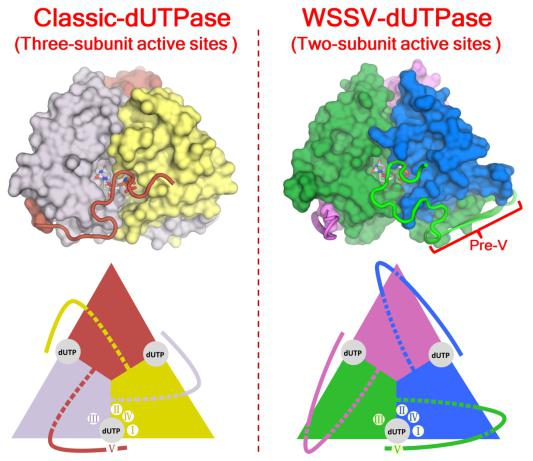
White spot syndrome virus (WSSV) is a serious pathogen in shrimp aquaculture, causing $1 billion economic loss every year since its emergence more than 20 years ago. So far, its replication mechanism is not understood and no effective treatment is available.
WSSV genome encodes more than 180 proteins and most of them have unclear functions. A rather complete thymidylate biosynthesis pathway is encoded in WSSV genome, despite that the host can provide thymidylate.
dUTPase is an enzyme in this pathway, which is essential for both thymidylate synthesis and viral genome integrity maintenance.
Recently, researchers from the Institute of Oceanology of the Chinese Academy of Science (IOCAS) found that WSSV dUTPase adopts a structural form distinct from classic dUTPases, providing a unique opportunity to develop antiviral drugs against WSSV infections. Their study was published in Journal of Biological Chemistry.
dUTPase catalyzes the hydrolysis of dUTP to dUMP and pyrophosphate (PPi) that are essential in cellular nucleotide metabolism. The trimeric dUTPase of WSSV (wDUT) has a sequence insert at the position preceding the C-terminal catalytic motif V (pre-V insert), which is rarely seen in other dUTPases.
Through X-ray crystallographic analysis combined with enzymatic assay, they observed that the pre-V insert in wDUT formed an unusual β-hairpin structure in the domain-swapping region, and thereby facilitated a unique orientation of the adjacent C-terminal segment, positioning the catalytic motif V onto the active site of its own subunit instead of a third subunit.
wDUT employs two-subunit active sites, unlike the widely accepted paradigm that the active site of trimeric dUTPase is contributed by all three subunits. According to structural comparisons, the active-site configuration of wDUT is similar to that of known dUTPases.
However, they also found that residues in the second-shell region of the active site are reconfigured in wDUT as an adaption to its unique C-terminal orientation. They hypothesized that this rare structural arrangement confered additional functionality to wDUT.
The study discovers a novel structural form of dUTPase and demonstrates how sequence insert and amino acid substitution in concert drive protein evolution. The structural information is valuable for antiviral drug design against the white spot syndrome virus.
This work was supported by the National Natural Science Foundation of China, the Thousand Talents Program of China, CAS "Hundred Talent Program", and the "AoShan Talents Program" of Qingdao National Laboratory for Marine Science and technology.

Comparison of active site assembly between classic dUTPase and WSSV dUTPase. (Image by IOCAS)

86-10-68597521 (day)
86-10-68597289 (night)

86-10-68511095 (day)
86-10-68512458 (night)

cas_en@cas.cn

52 Sanlihe Rd., Xicheng District,
Beijing, China (100864)

